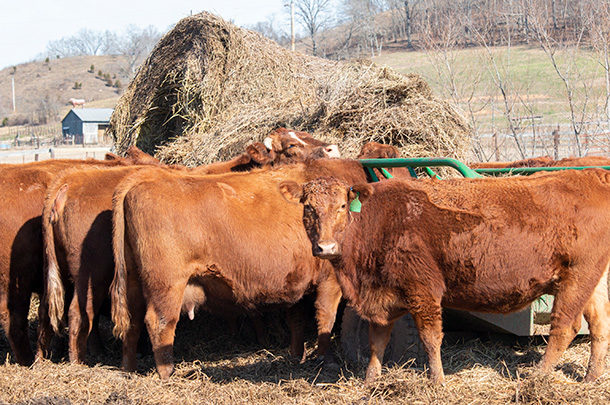
Nutrition during the third trimester plays a vital role in calf performance and future reproductive success. Staff photo.
4 factors during calving season that can impact rebreeding
Calving and rebreeding are two of the most notable events for a beef cattle operation. These two times of the year have a major impact on profitability.
As you begin this year’s calving season, think about some of the things you can do during this period to prepare cows for success during the breeding season. After all, beef cattle operations have a short window – only about 85 days – from calving to rebreeding that will allow an animal to stay within a 365-day calving cycle. How and when, in that period, females calve impacts their ability to be bred quickly and remain in your herd.
Consider these four factors to set your program up for success:
1. Monitor body condition
The body condition score (BCS) of a cow at calving influences many important aspects of health and well-being, such as colostrum quality, the cow’s ability to calve without assistance, calf vigor and the dam’s ability to recover from calving and resume cycling for rebreeding. BCS is the process of estimating an animal’s fat reserves.
The typical scoring system used in beef cattle ranges from 1-9. A score of 1 is emaciated whereas a score of 9 is extremely obese. A single BCS change up or down can represent a 75-pound change in bodyweight. Evaluating BCS before calving, after calving and prior to the breeding season is a valuable tool to ensure reproductive success.
Ideally, the BCS of a mature cow should be 5.5 to 6 at calving. However, heifers require a BCS of 6 or greater because of the additional nutritional requirements associated with their continued growth.
A decrease in BCS immediately following calving may be observed, but if the animal is on a proper nutrition program, it will regain BCS in a timely fashion and be prepared for the subsequent breeding season. If cows are not returning to optimal BCS within several weeks of calving, investigate potential causes to ensure underlying health or nutrition challenges don’t derail your breeding program and future calf crop.
2. Ensure proper nutrition
An easy and inexpensive way to ensure rations meet nutrient requirements of an animal is to obtain feed samples of available feedstuffs and submit them for analysis to determine their nutritional content. This knowledge will allow you to tailor the ration to meet, or in some cases exceed, animals’ needs during different trimesters of pregnancy and the post-calving period.
During the third trimester of gestation, 70% of fetal growth occurs. Nutrition during this time plays a huge role in calf performance and plays a crucial role in the future reproductive performance of the cow. After calving, maintenance requirements for a cow increase 25% to 30%. Ration supplementation to match or exceed these increased nutrient requirements is essential during this time.
3. Timely aid during difficult calvings
Time spent calving can affect an animal’s fertility later. Studies done at two USDA research centers showed that dystocia (calving problems) can delay the onset of estrus after calving. The studies found that for every hour a female is in stage two active labor (there is the appearance of membranes or water bag at the vulva) there is a four-day delay in the resumption of estrous cycles after calving. Early assistance also helps with conception following calving. The data showed a 16% higher conception rate in cows and heifers that were helped within the first 90 minutes of calving.
4. Optimize bull management
The herd bull is an often-overlooked animal during calving season. Failure to manage them correctly, especially prior to the breeding season, can lead to more open cows. When evaluating bull management, it is important to recognize that sperm production takes approximately 60 days. Because of this time lag, any management changes will not be manifested for at least 60 days after implementation. This means you must plan to make sure herd bulls are prepared for the breeding season.
As with cows, nutrition plays a vital role in the ability of a bull to do its job. Again, monitoring the BCS of bulls is important. A breeding bull should score 5 or greater on the BCS scale, with great care being given to not get them overly conditioned, since that will have a negative impact on health and performance. Pay special attention to young, yearling bulls as they are continuing to grow and will require a higher plane of nutrition to maintain a BCS of 5.
In spring-calving herds, there is also a need to monitor bull management during the cold months before use. Bulls will need bedding and access to shelter from the wind. There is an ability to recover from mild frostbite of the testicles, but severe frostbite can make a bull infertile. To prevent this possibility, ensure your bulls have windbreaks and adequate bedding.
As with any production system, there is a myriad of variables that impact your beef operation’s profitability. But, by controlling these four factors as part of a total management protocol, you increase the probability for success.
